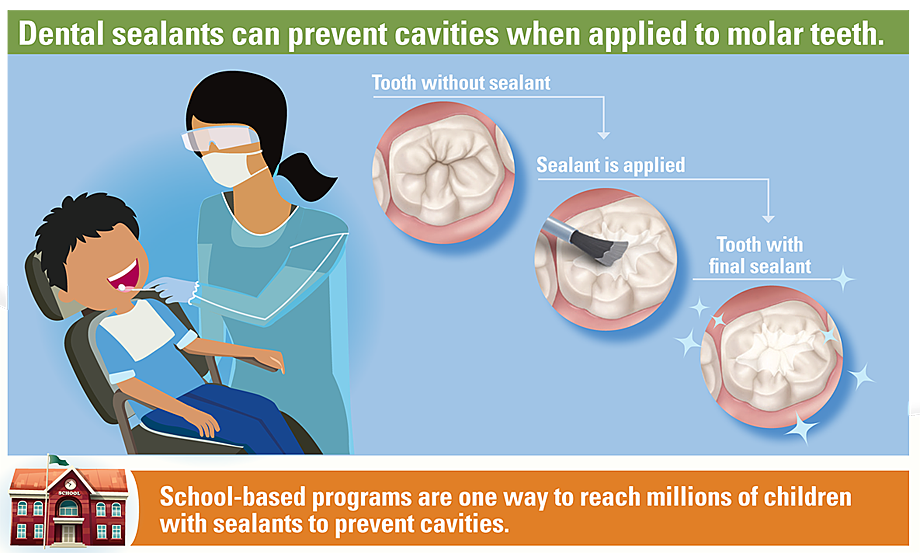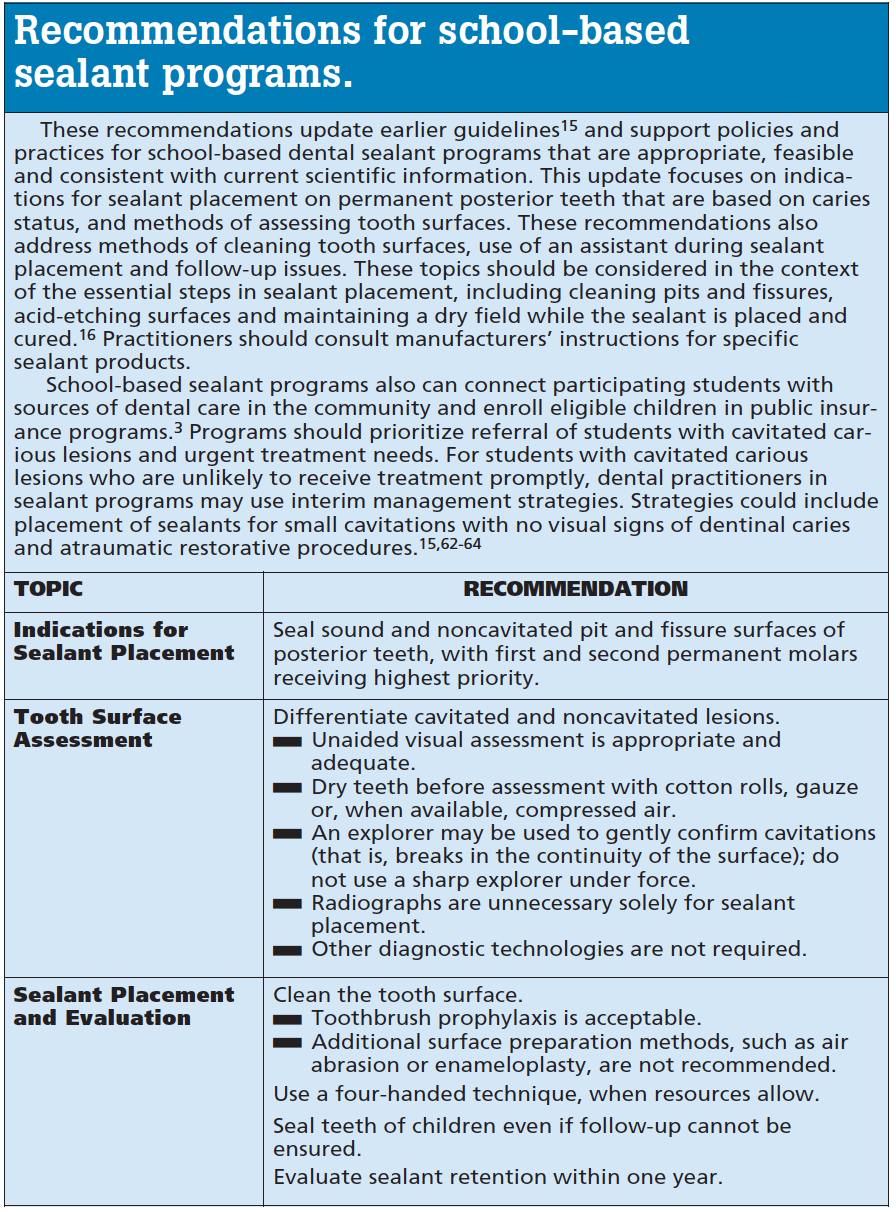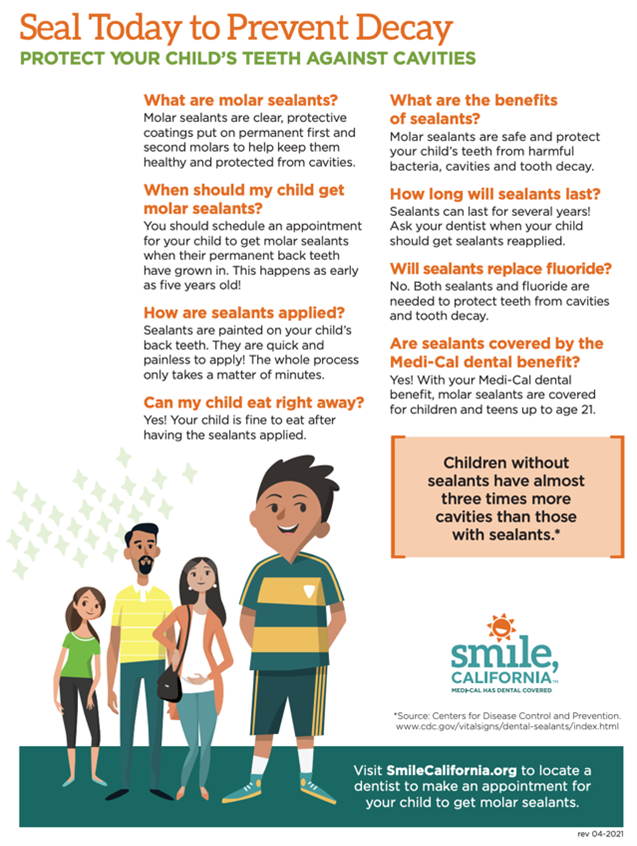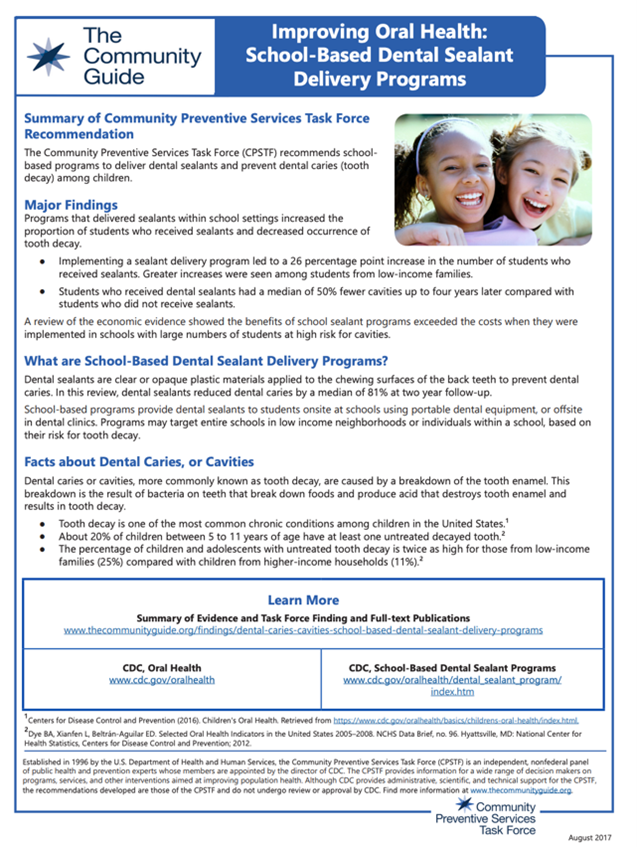
School-based programs are an effective way to bring preventive oral health services to children and may include more comprehensive services. The two most common services provided through school dental programs are sealants and fluoride varnish. Both these services help prevent dental caries (tooth decay) for children who may not have access to regular dental care and help keep children healthy and in school. To participate in school-based programs, dental professionals partner with the schools to gain permission to be onsite and obtain consent from the parents/caregivers.
School-Based Dental Sealants
What are dental sealants?
Dental sealants are a thin coating applied to the chewing surfaces of the back teeth (molars). Sealants are evidence-based, quick to apply, taking 2-3 minutes depending on the technique, and prevent up to 80% of cavities for 2 years and continue to protect against 50% of cavities for up to 4 years.
When to place dental sealants?
The best times to apply sealants are when the child’s 1st and 2nd permanent molars start to erupt around ages 6 and 12. In dentistry, the first and second molars are called the 6-year and 12-year molars. Sealants are most effective when applied soon after the permanent molars erupt to seal off the deep grooves on the chewing surfaces of the molars and provide more fluoride to the newly erupted tooth. Given oral hygiene is challenging at these ages, dental sealants can provide extra protection.
2nd and 3rd grade is the best time to apply dental sealants due to newly erupted molars.
Where can dental sealants be applied?
School-based programs can provide dental sealants to students at schools using portable dental equipment. Usually, school dental programs target schools in low-income neighborhoods known to have free and reduced lunch programs and to populations with a high risk for dental caries (tooth decay).

Who can apply dental sealants?
California-licensed dental professionals can apply dental sealants without supervision in a public health setting, including registered dental hygienists (RDH) and registered dental hygienists in alternative practice (RDHAP). Registered dental assistants (RDA) and registered dental assistants in extended function (RDAEF) can apply dental sealants with the direct supervision of a dentist.
How do dental professionals apply dental sealants and clinical guidelines?
Sealants are applied to healthy teeth to create a shield on the chewing surfaces of the tooth to prevent bacteria from causing tooth decay. A visual assessment is supported by the American Dental Association (ADA) and the Centers for Disease Control and Prevention (CDC) as best practices to determine the placement of sealants.
Recommendations for school-based sealant programs
Equipment
Selecting supplies and equipment (see below for step 4 of Seal America: The Prevention Invention):
- ADA Clinical Guidelines Chairside Guide
- Dental technique for glass ionomer dental sealant video
- Dental technique for resin-based dental sealant video
Dental sealant trainings and resources:
- National Maternal and Child Oral Health Resource Center School-based Dental Sealant Training Program
- Seal America a step-by-step best practices guide to starting a school sealant program
- Association of State and Territorial Dental Directors (ASTDD) Best Practices Approach: School-Based Dental Sealant Programs
- Infection Prevention & Control Guide for School Sealant Programs by Organization for Safely, Asepsis and Prevention (OSAP)
Publications:
- Darsie B, Conroy S, Kumar J. Oral Health Status of Children: Results of the 2018–2019 California Third Grade Smile Survey. J Calif Dent Assoc. 2021 May 1;49(5):331–6. https://www.cdph.ca.gov/Programs/CCDPHP/DCDIC/CDCB/CDPH%20Document%20Library/Oral%20Health%20Program/California_2019_3rd_Grade_Smile_Survey_20210730.pdf
- Gooch BF, Griffin SO, Gray SK, Kohn WG, Rozier RG, Siegal M, et al. Preventing Dental Caries Through School-Based Sealant Programs: Updated Recommendations and Reviews of Evidence. J Am Dent Assoc. 2009 Nov 1;140(11):1356–65. https://jada.ada.org/article/S0002-8177(14)64584-0/fulltext
Fluoride Varnish





